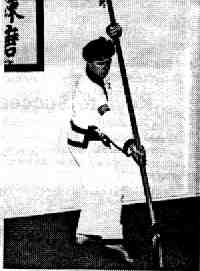
 |
| Defending Against Illness |
|---|
| In East Asia, martial arts and medicine have been intertwined for thousands of years. Many movements found in martial arts were initially developed to improve health and strengthen the body. One famous Master of the Chinese martial arts, Hwa-Ta (110 - 207 A.D.) was also a famous neurosurgeon, who was credited with performing the first known brain surgery (Medicine in China: A History of Ideas, Copy right 1985 by Paul U. Unschuld). Many martial artists in East Asia believe there are two ways to defend yourself throught the practice of Moo Doe. The first way is to strengthen your health to defend against invisible opponents (i.e. germs, viruses and other causes of illness and disease). The second way is against visible opponents. With the right knowledge, defending against someone's attack is simple. More often, however, the mental and physical skills gained from Moo Doe practice were more important in defending against unexpected situations, where mental concentration, alertness, speed, coordination and quick reflexes could protect against injury. |
Jim Dowling is the owner of and lead practitioner at Westside Acupuncture and Oriental Medicine in Seattle. Westside Acupuncture and Oriental Medicine offers a whole, complementary health system, including acupuncture, herbs, diet and exercise. Jim also is a Registered Nurse and holds a position as a Physician's Assistant with a local hospital.
Jim Dowling's unique qualifications place him on the cutting edge of the unification of Western and Eastern medicine.
The following is from a recent interview:
- For the readers' sake, what is the driving principle behind Oriental Medicine?
The Oriental medicine approach is about balance. Proper balance of all the systems of the body bring about good health, both mentally and physically. When someone is experiencing sickness or disease, or lack of good health, it is necessary to use herbs, acupuncture, medicine and dietary corrections to help restore the imbalance manifested by the sickness.
| "Around 90 percent if the people I see suffer from Chi Stagnation" |
|---|
-What is chi stagnation?
Chi stagnation is a condition where the energy in the body is not moving harmoniously, or is not flowing freely. This causes both physical and emotional problems. Some of the physical manifestations are pain, including headaches, stomach aches, ulcers and muscular skeletal pain. Dome emotional manifestations include frustration, depression, anger or an overall feeling of "stuckness" in life.
Prescribing medicines, herbs or dietary adjustments alone may not be adequately effective in alleviating the condition of chi stagnation that causes these problems. A restriction in the flow of energy throughout the body can block the effects of such prescriptions from reaching the areas where they are needed most. An engine that won't run properly because of a fuel line clog will not be fixed by adding more gas or a different type of fuel. The blockage must be removed before the engine will run properly again.
- How can a person prevent chi stagnation?
The most effective method I have seen of preventing chi stagnation is through the practice of Chung Moo Doe Main Hyung forms. These forms and movements are very well balanced and effective, as evidenced by the sustained feeling of well being that I and other practitioners experience when we practice these forms.
Conventional exercises such as aerobics of jogging are not balanced to overcome chi stagnation, nor were they designed for that purpose. When you do a Chung Moo Doe movement, it balances the energy throughout your body.
- What is the most pressing health need in our community?
A big problem in all medicine is one of compliance. Unless a patient takes the initiative and develops a healthy practice once a cure has been administered, then that person gets into a recurrence of the problem. Someone can go into a Chung Moo Doe school and develop that healthy practice and the motivation and discipline to continue, taking the initiative in preventing future problems and imbalances.
I find that too many people want someone else to take care of their problems. Once people realize how powerful they are in maintaining their own health and preventing problems, they are happy to try.
| page 2 |
| Back to page 1 | Next Article |
|---|---|
| Chung Moo Doe Schools in the Pacific Northwest | |
| Chung Moo Doe on the Web | |
Oom Yung Doe SitesRegional Sites
More Testimonials |